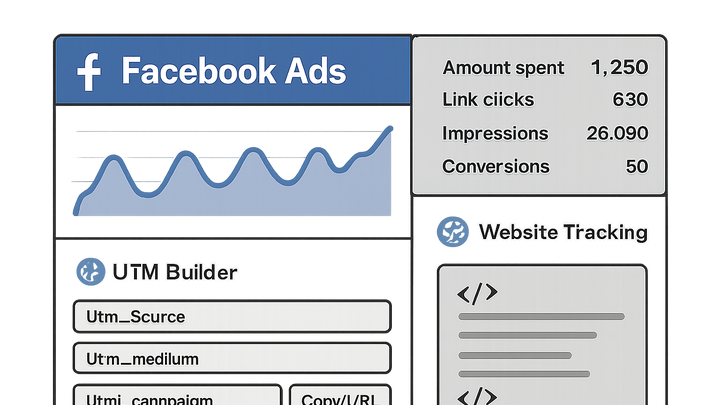Published on 2025-06-29T18:54:52Z
What are Facebook Ads? Examples of Facebook Advertising
Facebook Ads are paid advertisements displayed on Facebook, Instagram, and the broader Meta network. They allow businesses of all sizes to reach a highly targeted audience based on demographics, interests, behaviors, and custom data. Using Facebook’s ad platform, marketers can design campaigns around different objectives—such as brand awareness, traffic, conversion, or lead generation—and leverage dynamic creative tools for images, videos, or carousel formats.
By integrating UTM parameters and analytics tools like Plainsignal and UTMGuru, advertisers gain deep insights into campaign performance. You can generate and manage URLs with UTMGuru’s builder and Chrome extension, then add the Plainsignal snippet to your site for a privacy-first analytics view:
<link rel="preconnect" href="//eu.plainsignal.com/" crossorigin />
<script defer data-do="yourwebsitedomain.com" data-id="0GQV1xmtzQQ" data-api="//eu.plainsignal.com" src="//cdn.plainsignal.com/plainsignal-min.js"></script>
This setup helps you track clicks, conversions, and user journeys without relying on third-party cookies, ensuring compliance and data integrity.
Facebook ads
Paid ads on Facebook's platform enabling targeted campaigns and performance tracking with tools like Plainsignal and UTMGuru.
How Facebook Ads Work
Understand the core mechanics behind Facebook’s advertising platform, including how ads are delivered, targeted, and optimized.
-
Ad auction process
Facebook runs an automated auction to determine which ads to show based on bid, estimated action rates, and ad quality.
- Bidding:
Advertisers set a bid for desired actions (e.g., clicks or impressions) and compete in an auction.
- Ad relevance score:
A metric that reflects how well an ad resonates with its audience, impacting cost and delivery.
- Bidding:
-
Targeting options
Facebook offers granular targeting methods to reach the most relevant audience segments.
- Demographic targeting:
Filter audiences by age, gender, location, language, and more.
- Interest targeting:
Reach users based on interests, hobbies, and pages they follow.
- Custom audiences:
Use your own customer data or website visitors to retarget or create lookalike audiences.
- Demographic targeting:
-
Ad formats
Choose from various creative formats to deliver engaging ad experiences.
- Image ads:
Single image paired with a call-to-action button.
- Video ads:
Short or long-form videos that autoplay in users’ feeds.
- Carousel ads:
Multiple images or videos that users can swipe through.
- Image ads:
Tracking Facebook Ads Performance
Learn how to measure ad effectiveness using key metrics and specialized tools for privacy-first analytics and UTM management.
-
Key metrics
Monitor essential indicators to evaluate campaign ROI and optimize budgets.
- Ctr (click-through rate):
The ratio of clicks to impressions; a measure of ad relevance.
- Cpc (cost per click):
Average cost for each click on your ad.
- Cpa (cost per acquisition):
The average spend to acquire a conversion (e.g., sale, lead).
- Roas (return on ad spend):
Revenue generated per dollar spent on ads.
- Ctr (click-through rate):
-
Using plainsignal for cookie-free analytics
Deploy a lightweight, privacy-focused analytics script to capture user interactions without third-party cookies.
- Installation:
Add the PlainSignal preconnect link and script tag to your site’s
<head>section. - Event tracking:
Track pageviews, sessions, and custom events while preserving user privacy.
- Installation:
-
Utmguru for utm management
Simplify the creation, storage, and retrieval of UTM-tagged URLs to ensure consistent campaign attribution.
- Builder & generator:
Define UTM parameters and generate URLs via UTMGuru’s web interface.
- Chrome extension:
Create UTM URLs directly in your browser while browsing or sharing links.
- Url library:
Save, list, and manage all your UTM-coded URLs in one centralized dashboard.
- Builder & generator:
Best Practices for Facebook Ads Tracking
Implement guidelines to maintain data hygiene and improve the reliability of your campaign insights.
-
Consistent naming conventions
Use standardized UTM parameter values across all campaigns to avoid attribution discrepancies.
-
Implement facebook pixel & conversions api
Combine client-side pixel tracking with server-side Conversions API for robust data capture.
-
Leverage utm parameters
Tag all ad links with UTM parameters to unify tracking across Facebook and your analytics platforms.
-
Regular audit and cleanup
Periodically review your UTM links and analytics setup to remove outdated tags and scripts.
Example Implementation
Step-by-step guide to launch Facebook Ads campaigns with UTM tracking and PlainSignal analytics.
-
Step 1: define utm parameters
Choose clear values for utm_source, utm_medium, and utm_campaign to identify Facebook Ads traffic.
- Utm_source:
e.g., facebook
- Utm_medium:
e.g., cpc
- Utm_campaign:
e.g., summer_sale_2025
- Utm_source:
-
Step 2: generate and save urls with utmguru
Use UTMGuru’s builder or Chrome extension to create and store your tagged URLs.
- Access builder:
Open the UTMGuru web app and input your campaign parameters.
- Save & list:
Add your generated URLs to a named list for easy retrieval.
- Access builder:
-
Step 3: install plainsignal tracking code
Embed the PlainSignal script in your site’s header for instant analytics.
- Add `<link>` tag:
Include the preconnect link to optimize script loading.
- Insert `<script>` tag:
Use the provided script tag with your data-id to activate tracking.
- Add `<link>` tag:
-
Step 4: analyze campaign performance
Review UTM-labeled data in PlainSignal’s dashboard and correlate with ad metrics from Facebook Ads Manager.
- Filter by utm_campaign:
Segment reports to compare different campaigns.
- Generate reports:
Export CSVs or view visual graphs to share insights with stakeholders.
- Filter by utm_campaign:
